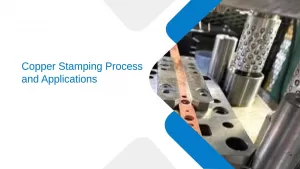What is Aluminium Metal Stamping and How It Works?
- Metal Stamping |
- Nov 25, 2025

Have you ever thought about how the metal pieces of daily use acquire such distinct outlines and smooth surfaces? A very big part of them is derived from the aluminum metal stamping process, which is a method that allows the industry to make parts that are light, strong and accurate at a very high speed. Stamped aluminium is becoming extremely essential as more and more industries are turning to lighter metallic materials for cars, gadgets and other essential machines. If you want to find out about the working process and the reason for the dependence of so many industries on it, read this guide to understand.
What Is Aluminum Metal Stamping?
Aluminium stamping is the method of pressing flat metal sheets into specific shapes through the application of dies and strong presses. The application of dies pushes the metal into the desired shape like a mould. The aluminium stamping process is exact and meticulous as a result of the softness of aluminium and the unique way it reacts under pressure. However, the general concept is the same as with other kinds of stamping.
Among other metal alloys, aluminium of different grades can be used. Among the common grades are:
| Temper | Common Grades | Composition |
| 1000 Series | 1050, 1060 and 1100 | 99.00%-99.99% Aluminium |
| 2000 Series | 2024, 2011 and 2014 | 2.2%-6.8% Copper |
| 3000 Series | 3003, 3004, and 3105 | 0.3%-1.5% Manganese |
| 4000 Series | 4032 and 4045 | 3.6%-13.5% Silicon |
| 0.1%-4.7% Copper | ||
| 0.05%-5.5% Magnesium | ||
| 5000 Series | 5052, 5083, and 5754 | 0.05%-5.5% Magnesium |
| 6000 Series | 6061, 6063, and 6082 | 0.2%-18% Silicon |
| 0.35%-1.5% Magnesium | ||
| 7000 Series | 7075 and 7050 | 0.8%-8.2% Zinc |
| 0.1%-3.4% Magnesium | ||
| 0.05%-2.6% Copper |
Stamped aluminium parts appear in many fields. Examples include automotive brackets, heat shields, frames, electrical housings, and small enclosures. These parts are often made with high precision through metal stamping services or progressive die stamping setups.
How Aluminium Metal Stamping Works?
Aluminium stamping follows a structured process. Here’s a simple step-by-step guide:
1. Design and Tooling
Engineers create a CAD model of the part and design the right die for it. Tool & die design is very important because aluminium reacts differently under pressure. A well-designed die ensures the particular part keeps the correct shape.
2. Material Preparation
Next up, the suitable aluminium plate is selected according to its strength, thickness, and the properties required. All the alloys have different characteristics, so choosing the right grade is very important.
3. Stamping Operations
Metal stamping with aluminium requires you to follow a structured process, which can be summed up as shown below:
- Punching: Creating holes or cut-outs
- Blanking: Cutting the sheet into a flat outline
- Bending: Folding the metal at set angles
- Drawing: Giving the sheet its final shape
Many factories use progressive die stamping, where the sheet passes through several stages in one continuous process. Others use transfer stamping, where each part moves from one station to another. Progressive systems are faster and ideal for large production, while transfer stamping works better for complex shapes.
4. Finishing and Quality Checks
Finishing steps are performed on parts after the shaping process, such as:
- Deburring: getting rid of cutting edges
- Surface cleaning or anodising: making the surface look better and more resistant to corrosion
- Inspection: verifying criteria like size, shape, and strength
Some CNC machining or automated systems are utilised by a few plants to ensure that each part is the same and has the right dimensions throughout.
Benefits of Aluminium Stamping
Among the many reasons why aluminium stamping is the preferred choice, one key reason is:
Lightweight yet Strong
Aluminium is very much the case, as it is almost the same as steel, weight-wise, but still strong enough to satisfy the structural requirements of many applications.
Excellent Corrosion Resistance
It is difficult for it to rust, so this is a reason why it is used in outdoor marine applications and more.
Environmentally Friendly
The recyclability of aluminium implies that not only will the parts with stamping contribute to waste reduction, but also they will play a role in the production process of eco-friendly products, as they will be made of recycled material.
Common Applications of Stamped Aluminium
Stamped aluminium parts appear in many industries:
- Automotive: Heat shields, brackets, panels, and EV battery supports.
- Aerospace: Electrical connectors, structural frames, and light supports.
- Electronics: Device enclosures, housings, and heat sinks.
- Consumer Goods: Handles, covers, decorative parts, and kitchen products.
Factories that offer precision metal fabrication or custom metal parts often use aluminium stamping to create clean, accurate components.
Challenges in Aluminium Metal Stamping
Although aluminium has many advantages, it also presents difficulties:
Soft Material and Springback: Dents can be created by its softness, and after bending, the material tends to spring back to its original shape. Dies have to be designed to ocntrol this.
Requirement of Lubrication: Friction is minimised and surfaces are made smooth with the help of proper lubrication.
Accuracy in Fast Production: High-speed stamping requires a lot of things, like stable equipment and skilled operation, to prevent any changes in shape or the formation of cracks.
Choosing the Right Aluminium Stamping Partner
The quality and cost will vary greatly depending on the chosen stamping company. Hence, it is important to look for:
- Certifications like ISO 9001 or IATF 16949
- Experience in aluminium stamping
- Advanced tools such as progressive die setups and CNC systems
- Full-service support from design to final finishing
A trustworthy companion will assist you in making the right selection of alloys, designing, tooling and planning the expenses.
Conclusion
Aluminium stamping is a fast, precise and economical way to produce strong and light components. It is applicable in areas that require exactness, quickness and eco-friendly materials.
If you need a reliable partner for aluminium stamping or custom metal parts, Eigen Engineering has modern tools, skilled personnel and complete support. Our stamping, manufacturing and designing capacities enable you to receive superior parts with uniformity in output. Visit our site to learn more or request a project consultation.




